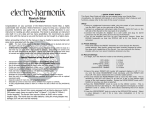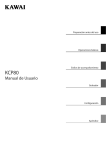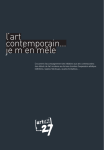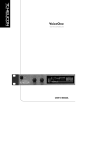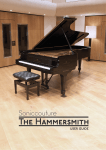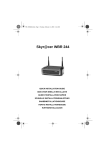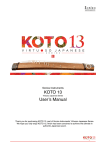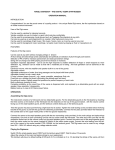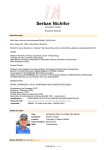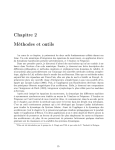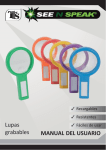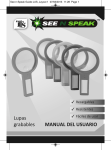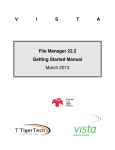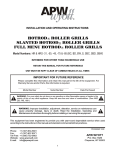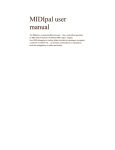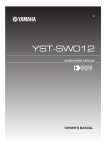Download here - m!lTone | Air Synth
Transcript
LLC ® Contact [email protected] Website http://www.miltone.net Air Synth & MIDI Controller ® © Copyright 2014. m!lTone is a registered trademark of Bahu Music LLC. All other trademarks included herein are the property of their respective owners. (Design and specifications are subject to change without notice). Designed and Assembled in Austin, TX Monday, December 15, 2014 User manual www.miltone.net Preface You have just opened a box to a device that truly allows one to create & explore music, control video, lights, and more handsfree. The possibilities and endless as one can connect many m!lTones together through MIDI. Please let us know what you think of the m!lTone. We want to grow a community of developers and tinkerers to push and see what the limit are on this device. What will you make it do? How will you use it? The m!lTone is open source and over time new features will be added. We will also be taking requests to add specific functionality on the m!lTone. If there is any functionality you would like please email [email protected] Thank you for backing the m!lTone. We hope you enjoy it! Monday, December 15, 2014 Index 1 Overview ................................................................................................................... 3 1.1 Controls ............................................................................................................ 3 1.2 Connectivity & Power ...................................................................................... 4 1.3 LCD Menu ........................................................................................................ 5 1.4 Knob Function Mapping ................................................................................ 6 2 Air Controls ............................................................................................................. 7 2.1 Air Index Modes ............................................................................................... 7 2.2 Air Modes .......................................................................................................... 9 2.3 Air En/Disable ................................................................................................. 11 2.4 Air Min Distance ............................................................................................ 11 2.5 Air Max Distance ............................................................................................. 11 2.6 Air Window Size ............................................................................................... 11 2.7 Air Bend Center ............................................................................................... 12 2.8 Load Air Controls ............................................................................................. 12 2.9 Save Air Controls .............................................................................................. 12 3 Synthwave Mode ...................................................................................................... 13 3.1 3.1 3.2 3.3 Synthwave Mode ............................................................................................ 13 Synthwave Display ......................................................................................... 13 Synthwave Buttons ......................................................................................... 14 Synthwave Knobs ........................................................................................... 15 3.4 Synthwave Knob Mapping ............................................................................ 16 3.5 Synthwave Air ................................................................................................. 17 4 Hulusi Mode ............................................................................................................ 19 4.1 Hulusi Display ................................................................................................... 19 4.2 Hulusi Buttons .................................................................................................. 20 4.3 Hulusi Knobs ..................................................................................................... 21 4.4 Hulusi Air .......................................................................................................... 22 1 Monday, December 15, 2014 Index 5 Harmonizer Mode .................................................................................................... 23 5.1 Harmonizer Display ........................................................................................ 23 5.2 Harmonizer Buttons ....................................................................................... 24 5.3 Harmonizer Knobs .......................................................................................... 25 5.4 Harmonizer Air ............................................................................................... 26 6 Scale/Key/TET ....................................................................................................... 27 7 Tempo ...................................................................................................................... 28 7.1 BPM ............................................................................................................... 28 7.2 Tempo Multiplier .......................................................................................... 28 7.3 Tempo Chain .................................................................................................. 28 8 ADSR ...................................................................................................................... 29 9 Arpeggiator ............................................................................................................. 30 9.1 Arp Effect ........................................................................................................ 30 9.2 Chain Patterns ............................................................................................... 31 9.3 Arp Pattern .................................................................................................... 32 9.4 Sweep Direction ........................................................................................... 32 10 Settings .................................................................................................................. 33 6.1 m!lTone Mode ............................................................................................... 33 6.2 Load Instrument Preset ............................................................................... 33 6.3 Save Instrument Preset ................................................................................ 33 6.4 Splash Disable .............................................................................................. 34 6.5 Menu Display Time ..................................................................................... 34 6.6 Factory Reset ................................................................................................ 34 6.7 Dump EEPROM .......................................................................................... 34 11 12/24 TET SCALES............................................................................................... 35 2 Connectivity & Power Controls Air Sensor I Air Sensor 2 Knob 1, Knob 2, Knob 3, Knob 4 LCD MIDI In DC Jack 9 - 12 V DC Rotary Encoder Power Switch ON IN 0 11 Audio Out 10 OUT MIDI Out Main Button Speaker Volume Button 1 Button 2 Button 3 Button 4 1/4 “ Audio Out Button 5 1.2 Connectivity & Power 1.1 Controls The m!lTone comes with three modes: Synthwave, Hulusi, and Harmonizer mode. The buttons and knobs have different functionality depending on the mode selected. The m!lTone is equipped with the following: Up to 2 ultrasonic (Air) sensors 4 configurable knobs (pots) The m!lTone can be powered with: 9V battery 6V 2 Watt Solar Panel (minimum) 9 - 12 V center pin positive DC power supply with a 2.1mm jack The m!lTone is equipped with with: 6 buttons 1 rotary ecoder knob/button to access and modify menu and parameters 1/4” stereo audio out MIDI in MIDI out/software thru 3 Monday, December 15, 2014 4 LCD LCD Menu 1.4 Knobs Function Mapping 2x16 LCD Display Rotary Encoder/Button 1.3 LCD Menu To access and modify the menu use the rotary encoder/button as shown above. Turn to scroll between menu items and press to enter the submenu. Scroll to the value or submenu and press to enter or apply changes. Hold the menu button for at least 1/3 of a second to return to the previous menu or submenu. Hold the menu button for at least 1.5 seconds to return to the main menu. The main menu items will display centered on the top line. The submenu will display left justified following “->.” -> Submenu The selection will display left justified following “-.” -> Submenu - Selection 5 Monday, December 15, 2014 Main Menu The bottom row of the LCD displays the functions of each knob. The names in the figure on the right correspond to the functionality of knobs 1, 2, 3, and 4, respectively. 1st 2nd 3rd 4th The functionality of each of the four knobs can be modified by holding the shift button (button 5) and the button of the knob you would like to change. This only applies to Synthwave and Hulusi modes. The table below shows the functions the knobs can perform. Display Nt1 Vl1 Wv1 Nt2 Vl2 Wv2 2Of Nt3 Vl3 Wv3 3Of Atk Dec Sus Rls TrS TrD Mod BPM Knob Function Mapping Inst 1 Note or Air 1 Delta Inst 1 Volume Inst 1 Wavetype Inst 2 Note or Air 2 Delta Inst 2 Volume Inst 2 Wavetype Inst 2 Note Offset Inst 3 Note Inst 3 Volume Inst 3 WaveType Inst 3 Note Offset Attack Time Decay Time Sustain Time Release Time Tremelo Speed Tremelo Depth Sweep & Random Arp Range Beats Per Minute 6 Air Controls O b j e c t 2.1.1 Discrete Air Index Mode Discrete Air Index Mode breaks up the distance between the object/hand and sensor into discrete values so that the index value is always a whole number. Only notes within the selected scale can be played. ∆ 2.1 Air Index Modes The m!lTone translates the distance to an object to something called an index. For every index delta (∆) distance travelled, the index gets incremented by 1. There are several Air Modes that determine how more precisely distance gets translated to an index. These modes are described in section 2.2. The value of the index gets translated as a note in a scale or can be outputted directly as a MIDI Controller message. There are three Air Index Modes that change whether the index values are discrete or continuous. Continuous index values allow for all of the notes in between two notes of a scale to be played. These index modes are described in sections 2.1.1-2.1.3. The index delta can be changed using a knob. When moving the knob, the value displayed on the screen shows the index delta in millimeters. Moving the knob all the way to the left automatically sets the index delta so that all notes can be played depending on the scale and the Min and Max Air Distance settings. Moving the knob slightly more the right will automatically set the index delta so that the index value goes all of the way from 0 to 127. To change between “Air Index Modes” navigate to menu “Air Controls->Air # Index Mode” or hold button 1 or button 2 for at least half a second in either SynthWave or Hulusi mode and select the desired Air index mode. 7 Monday, December 15, 2014 Air Index Modes 2.1.2 Continuous Air Index Mode Continuous Air Index Mode is similar the Theremin. This index mode defaults the BPM to Infinity “Inf ” only for the instrument using the Air sensor. The BPM of the other instruments will be the BPM. 2.1.3 Weighted Air Index Mode Weighted Air Index Mode is a mix of Continuous and Discrete. In this index mode, the value of the index will be a whole number for 75% of the index delta space and the remaining 25% will be continuous to the next index value. This allows for a note in the scale to be played, but pitch bent into the next or previous note in a scale. Use two hands/objects to do a “divebomb” effect. This index mode also defaults the BPM to Infinity “Inf ” only for the instrument using the Air sensor. 8 Air Controls Air Modes 2.2.2 Air Mode “Normal “ Normal Down is the same as Normal Up except the index will increase and the object gets closer to the sensor. O b j e c t 2.2.3 Air Mode “Hold ∆ “ Hold Up is the same as Normal Up except the index value does not revert to 0 whenever the hand/object is removed, but will remain the same as it was when the object was removed. 2.2 Air Modes Air modes adjust how the movements of the hand/object in front of the sensor determine what the index value should be, and which note gets played. Air Controls 2.2.4 Air Mode “Hold “ Hold Down is the same as Hold Up except the index will increase and the object gets closer to the sensor. To change between “Air Modes” press the shift button and press button 1 or 2 to cycle between the modes in the SynthWave or Hulusi modes. You can also navigate to menu item “Air Controls->Air Mode” and select the desired mode. 2.2.1 Air Mode “Normal “ Normal Up will make the index increase as the object gets farther away from the sensor. The lowest note will play when the hand/object is closest to the sensor. When there is no object present, the index value will be 0 and no note will be played. 9 Monday, December 15, 2014 2.2.5 Air Mode “Hold & Continue “ 2.2.6 Air Mode “Hold & Continue “ 2.2.7 Air Mode “Hold & Continue Window “ 2.2.8 Air Mode “Hold & Continue Window “ 10 Air Controls Air Controls 2.6 Air Window Size Air window size only applies to Air Mode “Hold and Continue Window.” Navigate to menu “Air Controls->Air WindowSize” to set the window size in index delta’s that allows a hand/object to modify the value. The value can be changed from 1 to 4. 2.3 Air En/Disable The Air sensors can be enabled and disabled by pressing button 1 or button 2 in SynthWave and Hulusi modes. You can also navigate to menu “Air Controls->Air En/ Disable” to toggle the sensors on and off. The LED next to the Air sensor{s} will flash green when enabled. 2.4 Air Min Distance Navigate to menu “Air Controls->Air Min Distance” to modify the closest distance to the Air sensor registers. The distance can be changed from 128 to 2048. If Air 1/2 is enabled when entering this submenu, one can hold their hand to the distance they want to be the minimum and press the main button to set it. 2.7 Air Bend Center Air Bend Center only applies to Air Mode “Bend.” Use the rotary encoder to navigate to menu “Air Controls->Air Bend Center” to change the default index value for when an object/hand in not in front of the Air sensor. This value should be 64 if you are outputting pitch bend MIDI messages. Alternatively, this can be set to another index value. For example, if a player would like the 15th note in a scale to be played whenever they move their hand away from the sensor, then set this value to 15. 2.8 Load Air Controls There are eight user Air presets that can be loaded, modified, and saved. Navigate to menu “Air Controls-> Load Air Ctrls” to load an Air preset. Different Air presets can be assigned to Air 1 and Air 2 sensors. 2.5 Air Max Distance Navigate to menu “Air Controls->Air Max Distance” to modify the furthest distance to the Air sensor that registers. The distance can be changed from 2048 to 8092 If Air 1/2 is enabled when entering this submenu, one can hold their hand to the distance they want to be the maximum and press the main button to set it. 11 Monday, December 15, 2014 2.9 Save Air Controls There are eight user Air presets that can be loaded, modified, and saved. Navigate to menu “Air Controls-> Save Air Ctrls” to save an user Air preset. When saving a preset the following is saved: Air Index Mode, Air Mode, Air Min Distance, Air Max Distance, Air Window Size, and Air Bend Center. 12 Synthwave Mode Synthwave Buttons 3 Synthwave Mode Synthwave mode allows the user to use the knobs and/or handsfree sensors to play music and send MIDI messages. To play in “Synthwave” Mode navigate to “Settings->m!lToneMode” in the menu. Select Synthwave mode and press the clear button to set it. This mode supports 3 instrument polyphony and can output over three separate MIDI channels. Each instrument’s wavetype, MIDI Channel, and ADSR settings can be modified as well instrument 2 and 3’s Note Offset. Number of Instruments Instrument MIDI Channel 1 to 3 1 to 16, Disable Instrument Wavetypes ADSR Sine, Square 1, Pulse, Saw, Tri Dist, Triangle, Organ, Noise Attack time - 10 to 520 Decay time - 10 to 520 Sustain level - 0 to 127 Release time - 10 to 520 Instrument 2 & 3 Note Offset -5 to 10 3. 1 Synthwave Display x x x The LCD display shows the functionality of the knobs Nt1 Vl1 Mod BPM on the bottom row and the notes being played on top. (Synthwave mode default display) To change the number of instruments press button 4 or navigate to menu “Synthwave->Num Instruments.” Although the functions of the knobs are configurable, they will reset to the defaults in the table below every time the number of instruments is changed. Number of Instruments = 1 Instruments = 2 Instruments = 3 13 Monday, December 15, 2014 2 Vl1 Nt2 Nt2 3 Mod Vl1 Nt3 4 BPM Vl2 Vl3 Access menu and modify settings [ [ ] Air 2 Map Tap Tempo Air 1 On/Off [ Air 1 Mode Toggle Octave Up Air 2 On/Off ][ Shift Change Number of Notes ][ ] [ Air 1 Mode Toggle Change Key ] ] Change Arp Effect [ ] [ ][ ][ ] Knob 1 Map Knob 2 Map Knob 3 Map Knob 4 Map 3. 2 Synthwave Buttons The functionality of the buttons are shown above. Press the shift button (button 5) to [] the buttons when shift is pressed. The buttons above in [ ] are the functionality of change the mapping of the buttons. The buttons above in the button when shift is held. 14 are the functionality of Synthwave Knobs Synthwave Knobs 3. 3 Synthwave Knobs 3.4 Synthwave Knobs Mapping The LCD display shows the functionality of the knobs on the bottom row and the notes being played on top. To change the number of instruments press button 4 or navigate to menu “Synthwave->Num Instruments”. The knob functionality is changed when changing the number of instruments as shown in the table of the previous page. The functionality of each of the four knobs can be modified by holding the shift button and the button of the knob you would like to change. The table below shows what each knob can be assigned to in synthwave mode. Knob 1 Options Inst 1 Note or Air 1 Delta The default functionality of the knobs in Synthwave mode are shown below. Instrument 2 & 3 will play an interval offset from Instrument 1 when knobs 2 & 3 are set to “Note Follow” position as shown below. The note offset can be changed in Synthwave menu. Knob 1 Knob 2 Air 1 Note Delta Air 2 Note Delta * Air Mode Enabled Knob 1 Instrument 1 Instrument 1 Off Knob 2 Instrument 2 Note follow Instrument 2 Off 15 Monday, December 15, 2014 Knob 3 Instrument 3 Note follow Knob 3 Options Knob 4 Options Inst 1 Volume Inst 1 Volume BPM Inst 1 Volume Inst 2 Note or Air 2 Delta Inst 2Volume Inst 2Volume Inst 1 Wavetype Inst 2Volume Inst 3 Note Inst 3Volume Attack Time Inst 2 Wavetype Inst 3Volume Release Time Inst 2 Note Offset Inst 3 Wavetype Sweep & Random Arp Range Decay Time Inst 3 Note Offset Tremelo Speed Susatin Level Knob 4 Tremelo Speed BPM Tremelo Depth Tempo Follow Instrument 3 Off Knob 2 Options Tap Tap Tempo Sweep & Random Arp Range 16 Synthwave Air O b j e c t ∆ Air 1 Air 2 On/Off On/Off 3. 5 Synthwave Air In Synthwave mode the user can use “Discrete Air”, “Continuous Air”, and “Weighted Air” index modes. Press button 1 or 2 to enable and disable Air 1 and 2 respectively. You can also navigate to “Air Controls->Air Enable” in the menu and toggle Air 1 and Air 2. The led will flash green to indicate that the handsfree sensor is on. Knobs 1 and 2 will change to “Air delta” functionality. The m!lTone Air modes are explained on page 9. Each sensor can be mapped to modify many of the functions that each knob can modify. 17 Monday, December 15, 2014 18 Hulusi Mode Hulusi Buttons 4 Hulusi Mode Hulusi mode emulates the Chinese flute “Hulusi”. The word Hulusi translates to silk gourd and is said to have a silky tone to the instrument. The Hulusi consists of three pipes the first of which is able to play notes in the scale. The 2nd and 3rd pipes act as resonators that play an interval of the key of the instrument. Two additional voices (drones) will play relative to the key selected. Access menu and modify settings The m!lTone expands on the Hulusi by allowing the use of hundreds of different scales. The Hulusi flute has sounds similar to square and sawtooth waves. One can modify the wave type of each of the three notes and can closely match the real sound of the Hulusi flute. To play in Hulusi mode navigate to “Settings->m!lTone Mode” in the menu. Select “Hulusi” mode and press the rotary encoder button set it. Hulusi mode supports 3 instruments(note polyphony) and MIDI channels. You can modify each instrument’s wave type, MIDI Channel, and ADSR settings in “Hulusi” menu. Instrument Wavetypes Notes Off (Hold) Ping 1 On/Off [ Sine, Square 1, Pulse, Saw, Tri Dist, Triangle, Organ, Noise Air Delta Change Scale Ping 2 On/Off ] [ Air Delta ] [ Change Key Change Arp Effect ][ [Shift ] ] Change Arp Effect Instrument MIDI Channel 1 to 16, Disable 4. 2 Hulusi Buttons 4. 1 Hulusi Display x The LCD display shows the functionality of the knobs on the bottom row and the notes being played on top. The number of instruments is always three and cannot be changed in Hulusi mode. 19 Monday, December 15, 2014 Nt1 Vl1 x x Vl2 BPM (Hulusi mode display) The functionality of the buttons are shown above. The buttons do the same as Synthwave mode. The arpeggiator effect will modulate on instrument 1 only. Holding the main button will begin the release phase of the ADSR and mute all the sounds. 20 Hulusi Air Hulusi Knobs O b j e c t ∆ Instrument 1 /Air 1 Delta Instrument 2 Volume Instrument 3 Volume BPM 4.3 Hulusi Knobs 4.4 Hulusi Air In Hulusi mode the knobs functionality cannot be changed. The table below and the figure above show what the knobs can modify. Knob 1 Knob 2 Knob 3 Mapping Mapping Mapping Instrument 1 Instrument 2 Instrument 2 / Air 1 Delta Volume Volume 21 Monday, December 15, 2014 Knob 4 Mapping Navigate to “Air Controls->Air 1 Enable” in the menu and enable or disable Air 1. The LED will flash green to indicate that the handsfree sensor is on. Knobs 1 changes from “Root Offset” to “Air delta” functionality. Turn back to page 9 to learn about the Air delta and Air modes. BPM 22 Harmonizer Mode Harmonizer Buttons 5 Harmonizer Mode Access menu and modify settings Harmonizer mode allows the user to play the buttons like a piano expect the buttons only play the notes of the selected scale. Harmonizer mode supports 5 instruments (note polyphony) and MIDI channels. You can modify each instrument’s wavetype, MIDI Channel, Air Source, and ADSR settings. To play in “Harmonizer” mode navigate to “Settings->m!lTone Mode” in the menu and select it. Instrument Wavetypes Sine, Square 1, Pulse, Saw, Tri Dist, Triangle, Organ, Noise Sustain Note 1 Instrument MIDI Channels Note 2 Note 3 Note 4 Note 5 1 - 16, Disable 5. 1 Harmonizer Display Harmonizer mode displays the notes of the buttons being played on the bottom row of the LCD. When the sustain button (main button) is pressed an “s” will appear in the leftmost bottom corner. Roo TrS TrD BPM s Nt1 Nt2 Nt3 Nt4 Nt5 The top row of the LCD always and only displays the following four values: 1 - the note that the first button that will play 2 - value of of the tremelo speed 3 - value of of the tremelo depth 4 - BPM 23 Monday, December 15, 2014 5. 2 Harmonizer Buttons The functionality of the buttons are shown above. There is no shift button in Harmonizer mode. Each button plays the next note in the selected scale. The main button will sustain the notes of the buttons that are held down. Each button can be assigned to a different instrument preset if desired. 24 Harmonizer Air Harmonizer Knobs O b j e c t ∆ Root Note Offset /Air Delta Tremelo Speed Tremelo Depth BPM 5. 4 Harmonizer Air 5.3 Harmonizer Knobs The knobs functionality cannot be changed in Harmonizer mode. The table below and the figure above show what the knobs can modify. Knob 1 Mapping Root Offset / Air Delta Knob 2 Mapping Tremelo Speed 25 Monday, December 15, 2014 Knob 3 Mapping Tremelo Depth Knob 4 Mapping BPM Press button 1 or 2 to enable and disable Air 1 and 2 respectively. Navigate to “Air Controls->Air 1 Enable” in the menu and enable or disable Air 1. The LED will flash green to indicate the Air sensor is on. Knobs 1 changes from “Root Offset” to “Air delta” functionality. Select between Air Source 1 or 2 in the Harmonizer submenu and enable that sensor to use the handsfree sensor to change the root note. Navigate to “Harmonizer->Air Source” to choose which of the two sensors will modify the root note,. 26 Scale/Key/TET Tempo BPM Tempo Follow Tap 0 1022 Tap Tempo 7.1 BPM BPM is the number of beats (notes) played in one minute. The beats per minute can be set from 10 to 1022. Use the BPM knob to set the BPM modes like shown above. 6 Scale The m!lTone has over 200 scales from all over the world to choose from. The scale can be modified in the “Scale” submenu and will change when selecting between scales. A quarter tone is a pitch halfway between the usual notes of a chromatic scale. Imagine a piano with an extra pitch in between every key. That changes it from 12 tones to 24 tones per octave. 7.2 Tempo Multiplier Tempo Multiplier multiplies the value selected to the BPM. The tempo multiplier can be a value from 1 to 9. Navigate to “Tempo->Tempo Mult” to change the value. 7.3 Tempo Chain Key The key can be changed from the menu in “Scale/Key/TET->Key” or by pressing the shift button followed by button 3. Enable “Tempo Chain” when daisy chaining multiple m!lTones via MIDI cables. When the m!lTones down the chain are in tempo follow mode they will time sync with the m!lTone at the top of the chain. Turn the BPM knob to the left until the display shows “Fol” to be in tempo follow mode. There is a 1/3 rd millisecond delay per m!lTone daisy chained. MIDI IN MIDI OUT Scale TET Select between 12 Tone Equal Temperment (TET) and 24 TET to choose between half tone and quarter tone scales. The scales displayed in the Scales submenu will change based on the TET selected. To change between quarter tone and half tone scales change “Scale TET” in Scale/Key/TET menu. There are over two hundred 12 TET (half tone) scales and over forty 24 TET (quarter tone) scales. 27 Monday, December 15, 2014 Top of the chain (enable tempo chain) Bottom of the chain (set knob4 to “Fol”) 28 Arpeggiator ADSR 9 Arpeggiator 8 ADSR The “attack” and “decay” of a sound have a significant effect on the instrument’s sonic character. Navigate to a m!lTone Mode menu item and scroll to “ADSR” to modify the instruments ADSR envelope. The contour of an ADSR envelope is specified using four parameters Attack, Decay, Sustain, and Release. A sustain value of 127 and long release time is recommended when using the Air sensor(s). Atk x Dec x Sus x Rls x 9.1 Arp Effect Attack time - the time takes for a sound to reach its peak level 1 - No pattern is applied size = 16 Random Arpeggiator Sustain level - the level during the sustain phase of a sound Release time - the time taken for the level to decay from the sustain level to zero - Random arpeggiator will play a random note between the root note and within the step size selected using knob “Mod”. Hold shift and button 3 or 4 to cycle to “Mod.” Arpeggiator Chain Release - Arpeggiator chain is explained in detail on the following page. 127 Arpeggiator Envelope Level - Arpeggiator is explained in detail on the following page. Sustain Level Sweep 0 Time 29 Monday, December 15, 2014 Mod Max step None Decay time - the time takes for a sound to reach the sustain level from peak level Decay Knob 3 Below is a breakdown of the arpeggiator effects available. A “Mod” of value 1 has no effect on rand arp and sweep. (ADSR display) Attack There are 4 arpeggiator effects that can be changed by pressing shift followed by button 4 or via the menu under “Arpeggiator->Arp Effects.” A knob must be assigned to “Mod” to vary the number of notes for pattern for Random Arp and Sweep. The arpeggiator affects instrument 1 when one note polyphony is selected. Only instrument 2 is affected when two or three note polyphony are selected. - Sweep will continue to play the next note in the selected scale until the “Mod” step size is reached. Hold shift and button 3 or 4 to cycle to “Mod.” 30 Arepeggiator Arepeggiator 9.3 Arp Pattern 9.2 Chain Pattern There are a total of 90 arpeggiator chain patterns that can be selected. Change the arp effect to “Arp Chain” to use the chain pattern selected. All patterns consist of the indices to arpeggiator patterns. The example below explains chain pattern in detail. There are a total of 90 arpeggiator patterns that can be selected. Change the arp effect to “Arpeggiator” to use the selected arp pattern. Only patterns 10 - 99 can be selected. Patterns 0-9 are reserved for building arpeggiator chains. Patterns 10 - 99 consist of two intervals. The example below explains arpeggiator pattern in detail. C5 C5 Example Example Major Pentatonic: C5 D5 E5 G5 A5 C6 Major Pentatonic: C5 D5 E5 G5 A5 C6 Pattern Description 1: 10 - 22 - 44 Plays arp pattern 10 followed by arp pattern 22 followed by 44 and repeats 2: 10 - 2 - 4 Description 10: 0 - 1 Plays C5 followed by D5 and repeats 11: 0 - 2 Plays C5 followed by E5 and repeats 12: 0 - 3 Plays C5 followed by G5 and repeats 23: 1 - 4 ... Plays arp pattern 10 followed by arp pattern 2 followed by 4 and repeats etc. Plays D5 followed by A5 and repeats etc. Arp chain pattern 2 as shown above will play arp pattern 1: 0 - 1 followed by arp pattern 2: 2 followed by 4: 4. The entire chain pattern is thus: 0 - 1 - 2 - 4 => C5 D5 E5 A5 repeat 31 Monday, December 15, 2014 Pattern 9.4 Sweep Direction The direction of the sweep effect can be to changed to Up, Down, or Up-Down. Sweep direction is Up by default and only affects the “Sweep” arp effect. 32 Settings Settings Splash Disable When the m!lTone is powered on a splash screen showing “m!lTone Air Synth” is displayed. Navigate to menu “Settings->Splash Disable” disable the splash screen. m!lTone Mode The m!lTone has three modes with different controls and ways of playing with the handsfree sensor. The modes available are Synthwave, Hulusi, and Harmonizer. The three modes are explained in detail in this guide. Refer to the index for the pages. Load Instrument Preset Menu Display Time Menu display time is the duration of time that the menu stays on the LCD. The menu display time can be changed from 244 ms to 5044 ms. The display time can be set in menu “Settings->Splash Disable” and will persist when powering off and on. Factory Reset The m!lTone is equipped with 32 presets that can be loaded on each individual instrument or on all instruments. Navigate to the “Settings->Load Inst Prst” to load the preset instrument (sound) of your liking. Doing a factory reset will permanently overwrite any new settings and presets saved and will not be able to retrieved. To restore the m!lTone with factory settings navigate to “Settings->Factory Reset” and select “yes.” Save Instrument Preset The m!lTone is equipped with 32 presets of which 16 can be saved. Saving an instrument preset saves the instrument’s wavetype, MIDI channel, ADSR, tremelo speed, tremelo depth, arpeggiator bank index, and arpeggiator chain index. The preset last used will be reatined when powering the m!lTone off and on. 33 Monday, December 15, 2014 Dump EEPROM This settings is only useful if the m!lTone is attached to a computer via an FTDI to USB programming cable. The contents of theEEPROM, which holds all saved presets, will get dumped on a serial console. 34 12 TET Scales Adonai Malakh - Aeolian Flat - Aeolian Natural Minor Asavari A to G - Algerian - Altered Pentatonic - Alternating TetraMirror - Augmented Chord - Augmented Messiaen Truncated Mode 3 Inverse - Balinese Pelog - Balinese Pentachord - Blues Dorian Hexatonic - Blues Enneatonic - Blues Heptatonic - Blues Minor - Blues Minor Maj7 - Blues Modified Blues Octatonic - Blues PentaCluster - Blues Pentatonic Minor - Raga Malkauns - Blues Phrygian - Blues V - Blues with Leading Tone - Center Cluster PentaMirror - Chaio - Chinese - Chromatic - Chromatic Bebop Chromatic DecaMirror Chromatic Diatonic Dorian - Chromatic Dorian - Chromatic Dorian Inverse - Chromatic HeptaMirror - Chromatic HexaMirror - Chromatic Hypodorian - Chromatic Hypodorian Inverse - Chromatic Hypolydian Inverse Persian Chromatic Hypolydian Puravi - Chromatic Hypophrygian Inverse - Chromatic Lydian - Chromatic Lydian Inverse Todi Chromatic Mixolydian - Chromatic Mixolydian Inverse - Chromatic NonaMirror - Chromatic OctaMirror Chromatic PentaMirror - Chromatic Permuted Diatonic Dorian - Chromatic Phrygian - Chromatic Phrygian Inverse - Chromatic TetraMirror - Chromatic TriMirror - Chromatic UndecaMirror - Diminished - Diminished 7th Chord 3 Semitones Diminished Chord Dominant Bebop - Dominant Pentatonic - Dorian Aeolian - Dorian Kafi - Dorian Pentatonic Kumoi Japan - Dorian Tetrachord - Dorian b5 - Double Phrygian Hexatonic - Egyptian Suspended Pentatonic - Enigmatic Major Verdi Enigmatic Ascending Enigmatic Minor - Eskimo Hexatonic 2 - Eskimo Tetratonic - Example Of Pelog - Example of Slendro - Full Minor Genus Chromaticum - Genus Secundum - Gipsy Hexatonic Raga Kalakanti - Half Diminished Symmetric Blues Dim - Han Kumo - Harmonic Major - Ethiopian Nat Bhairava - Harmonic Major 2 Ionian 5 Harmonic Minor - Harmonic Minor Inverse or Bhairav - Harmonic Minor Tetrachord - Harmonic Neapolitan Minor Hawaiian - Hindolita - Hirajoshi Japan - Honchoshi Plagal Form - Houseini Houzam - Hungarian Folk or Byzantine Hungarian Gypsy Damian Emmanuel - Hungarian Major Hungarian Minor Hungarian Minor b2 - Indian Phrygian dim 4th Ionian Major Bilaval - Ionian Pentatonic - Iwato Japan - JG Octatonic - Japanese Pentachord - Japanese Sakura Pentatonic Soft Descend - Jazz Minor Inverse Javanese - Kiourdi - Kokin Joshi Soft Ascend Japan - Kung - Leading Whole Tone - Locrian - Locrian Natural Maj 6 Pseudo Turkish - Locrian PentaMirror - Locrian bb7 - Lydian 2 - Lydian Hexatonic Augmented - Lydian Diminished - Lydian Dominant Overtone Bartok - Lydian Hexatonic - Lydian Kalyan F to E ascending naturals - Lydian Minor Stravinski - Lydian Mixolydian - Lydian Pentachord - Magen Abot - Major 7 Chord Major And Minor mixed - Major Bebop - Major Bebop Heptatonic - Major Blues - Major Locrian Major Lydian - Major Pentachord - Major Pentatonic - Major Tetrachord - Major Triad eg Ab - Major Triad eg C - Major Triad eg F - Major add 9 eg Ab add9 - Major add 9 eg Bb add9 - Major add 9 eg F add9 - Major b7 Chord eg Ab7 - Major b7 Chord eg C7 Major b7 Chord eg D7 - Major b7 Chord eg F7 - Maqam Hijaz - Maqam Shaddaraban - Marva or Marvi - Messiaen Mode 3 - Messiaen Mode 3 Inverse - Messiaen Mode 4 Messiaen Mode 4 Inverse - Messiaen Mode 5 - Messiaen Mode 5 Inverse - Messiaen Mode 6 - Messiaen Mode 6 Inverse - Messiaen Mode 7 - Messiaen Mode 7 Inverse - Messiaen Truncated Mode 2 - Messiaen Truncated Mode 3 Half Augmented - Messiaen Truncated Mode 5 Messiaen Truncated Mode 5 Inverse - Messiaen Truncated Mode 6 - Minor 6th Added - Minor 7th Messiaen Truncated - Minor 7th eg Am7 C6 - Minor 7th eg Dm7 F6 - Minor Bebop Minor Bebop Heptatonic - Minor Locrian - Minor Melodic - Minor Pentachord - Minor Pentatonic with Leading Tones - Minor Triad eg Am - Minor Triad eg Cm - Minor Triad eg Fm Mixolydian Augmented - Mixolydian Hexatonic - Mixolydian Khamaj G to F ascend - Mixolydian Pentatonic - Mixolydian b5 - Moorish Phrygian - Name Of Scale Neapolitan Major - Neapolitan Minor - Neapolitan Minor Mode - Neveseri Blues Phrygian - Enigmatic Minor - Marva - Minor Bebop - Phrygian Locrian - Prokofiev - Prometheus - Raga Madhuri - Rock - Two - Nohkan - Oriental - Oriental - Oriental 2 - Oriental Pentacluster - Phrygian Aeolian - Phrygian Bhairavi - Phrygian Dominant Dorico Flamenco Avaha Raba Spanish Folk Jewish Major - Phrygian Hexatonic - Phrygian Locrian - Phrygian Major Flamenco Spanish Phrygian - Phrygian Tetrachord - Prokofiev - Prometheus - Prometheus Neapolitan - Pyramid Hexatonic - Raga Abhogi - Raga Bagesri - Raga Chandrakauns Kafi - Raga Desh - Raga Gandharavam - Raga Harikauns - Raga Jayakauns - Raga Jyoti - Raga Khamaji Durga - Raga Latika Raga Madhuri Raga Malkauns - Raga Megh - Raga Mian Ki Malhar - Raga Nata - Raga Paraju - Raga Rukmangi Pelog 2 - Raga Shri Kalyan - Raga Tilang - Raga Trimurti - Raga Vaijayanti - Raga Valaji - Raga Vasanta - Raga Vasantabhairavi - Raga Vijayanagari - Raga Vijayasri - Raga Vijayavasanta - Raga Viyogavarali - Raga Vutari - Raga Yamuna Kalyani - Raga Zilaf - Ritsu - Ritusen Japan Scottish Pentatonic - Rock n Roll - Romanian Bacovia - Romanian Gnossiennes - Romanian Major Purvi - Sabach - Scottish Hexatonic - Scriabin Shostakovich - Spanish 8 Tones - Spanish Heptatonic - Spanish Pentacluster - Superlocrian Diminished Whole Tone - Symmetrical Nonatonic Takemitsu Tree Line Mode - Takemitsu Tree Line Mode 2 - Todi - Ultra Locrian - Utility Minor - Verdi Enigmatic - Verdi Enigmatic Descending - Warao - Whole 35 Monday, December 15, 2014 24 TET Scales Maqam AtharKurd - Maqam Bastanikar - Maqam Bayati - Maqam Farahfaza - Maqam Hijaz - Maqam Hijaz2 - Maqam HijazKar - Maqam HijazKarKurd - Maqam HijazKarKurd - Maqam Husseini - Maqam Huzam - Maqam Iraq Maqam Jiharkah - Maqam Karjighar - Maqam Kurd - Maqam Mahur - Maqam Mustaar - Maqam Nahawand - Maqam Nahawand2 - Maqam Nairuz - Maqam NawaAthar - Maqam Nikriz - Maqam RahatElArwah - Maqam Rast - Maqam Rast2 - Maqam Saba - Maqam Saba2 - Maqam SabaZamZam - Maqam ShaddAraban - Maqam Shehnaz - Maqam Sikah - Maqam Sikah2 - Maqam SikahBaladi - Maqam SikahBaladi2 - Maqam Sunbulah - Maqam Suzidil - Maqam Suznak - Maqam UshaqMasri - Maqam Yekah Maqam Yekah2 - Maqam Zanjaran 36 Appendix A.1 Install 9V Battery Follow the five steps below to remove and/or install a 9V battery. A phillips screwdriver is needed to remove the screws. A.2 Mic Stand Hex Nut The m!lTone can be secured on any standard mic stand using the hex nut provided. The inside of the bottom cover has been etched to seat the hex nut in its place. Follow the steps below to remove and/or install the hex nut. A phillips screwdriver is needed to remove the screws. 1. Remove the screws on the bottom sides 2. Remove the bottom cover using the backpanel notch 1. Remove the screws on the bottom sides 3. Place the battery in the battery clip until it sits securely 2. Remove the bottom cover using the backpanel notch 4. Put the bottom back with the battery on the side with no wires 5. Put in the screws and tighten until snug 3. Place the hex nut in the etched well and seat it until it is secure 4. Put the threaded part of the mic stand through the hole in the bottom cover and make sure it secures tightly to the hex nut 5. Put the bottom back with the battery on the side with no wires 6. Put in the screws and tighten until snug Monday, December 15, 2014





















